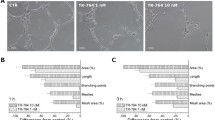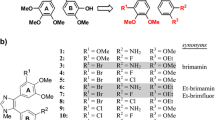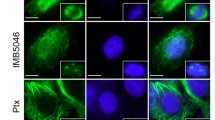Abstract
Purpose
Since anticancer agents that interfere with microtubule function are in widespread use and have a broad spectrum of activity against both hematological malignancies and solid tumors, there is an urgent need to develop novel tubulin inhibitors with broader activities and avoiding drug resistance.
Methods and results
In this study, we describe the characterization of select lead compounds from a novel class of indazole-based tubulin inhibitors. Three lead compounds, TH-337, TH-482 and TH-494, exhibit potent antiproliferative activity against cell lines derived from human pancreatic carcinoma, human breast adenocarcinoma and human colorectal adenocarcinoma cells. The three compounds were also tested for cytotoxicity against a panel of clinically relevant drug resistant cancer cell lines that either overexpress the drug resistance pumps MDR-1, MRP-1 and BCRP-1 or have altered Topoisomerase II activity. TH-482 and -494 retained cytotoxic activities against all of the resistant cell lines tested; however, TH-337 exhibited decreased cytotoxicity in the cell line overexpressing BCRP-1, indicating that TH-337 is a substrate of that pump. We show that TH-482’s antiproliferative activity is due to cell cycle arrest at the G2/M phase. We demonstrate that TH-482 binds specifically to the colchicine site of tubulin and that it inhibits tubulin polymerization in vitro in a concentration-dependent manner. The in vitro anti-vascular activities of TH-482 were assessed using the HUVEC-C cell line. TH-482 inhibits in vitro neovessel formation and disrupts pre-established vessels using HUVEC-C cells. TH-482 also increases permeability of vascular endothelial cells in a concentration- and time-dependent manner.
Conclusions
TH-482 demonstrates potent in vitro efficacy as a novel tubulin-targeted anti-proliferative and anti-vascular agent and notably is more potent in antiproliferative assays than the benchmark compound combretastatin A-4. These results identify TH-482 as a potent tubulin inhibitor, and support the investigation of its in vivo efficacy and pharmacokinetic properties as the prototype of a new class of anti-tubulin agents.






Similar content being viewed by others

Abbreviations
- MDR-1:
-
Multi-drug resistant-1
- MRP-1:
-
Multidrug resistance-associated protein-1
- BCRP:
-
Breast cancer resistant protein
- CA-4:
-
Combretastatin A-4
- ITC:
-
Isothermal titration calorimetry
- PEM:
-
Pipes, EGTA and MgCl2 (general tubulin buffer)
References
Hadfield JA, Ducki S, Hirst N et al (2003) Tubulin and microtubules as targets for anticancer drugs. Prog Cell Cycle Res 5:309–325
Jordan MA, Wilson L (2004) Microtubules as a target for anticancer drugs. Nat Rev Cancer 4:253–265
Yoshida D, Hoshino S, Shimura T et al (2000) Drug-induced apoptosis by anti-microtubule agent, estramustine phosphate on human malignant glioma cell line, U87MG; in vitro study. J Neurooncol 47:133–140
Mayer TU, Kapoor TM, Haggarty SJ et al (1999) Small molecule inhibitor of mitotic spindle bipolarity identified in a phenotype-based screen. Science 286:971–974
Tozer GM, Kanthou C, Baguley BC (2005) Disrupting tumour blood vessels. Nat Rev Cancer 5:423–435
Jain RK (2003) Molecular regulation of vessel maturation. Nat Med 9:685–693
Chang YS, di Tomaso E, McDonald DM et al (2000) Mosaic blood vessels in tumors: frequency of cancer cells in contact with flowing blood. Proc Natl Acad Sci USA 97:14608–14613
Lippert JW (2007) Vascular disrupting agents. Bioorg Med Chem 15:605–615
Nicholson B, Lloyd GK, Miller BR et al (2006) NPI-2358 is a tubulin-depolymerizing agent: in-vitro evidence for activity as a tumor vascular-disrupting agent. Anticancer Drugs 17:25–31
Peifer C, Stoiber T, Unger E et al (2006) Design, synthesis, and biological evaluation of 3,4-diarylmaleimides as angiogenesis inhibitors. J Med Chem 49:1271–1281
Davis PD, Dougherty GJ, Blakey DC et al (2002) ZD6126: a novel vascular-targeting agent that causes selective destruction of tumor vasculature. Cancer Res 62:7247–7253
Gottesman MM, Fojo T, Bates SE (2002) Multidrug resistance in cancer: role of ATP-dependent transporters. Nat Rev Cancer 2:48–58
Szakacs G, Annereau JP, Lababidi S et al (2004) Predicting drug sensitivity and resistance: profiling ABC transporter genes in cancer cells. Cancer Cell 6:129–137
Szakacs G, Paterson JK, Ludwig JA et al (2006) Targeting multidrug resistance in cancer. Nat Rev Drug Discov 5:219–234
Lee JS, Paull K, Alvarez M et al (1994) Rhodamine efflux patterns predict P-glycoprotein substrates in the National Cancer Institute drug screen. Mol Pharmacol 46:627–638
Shoemaker RH (2000) Genetic and epigenetic factors in anticancer drug resistance. J Natl Cancer Inst 92:4–5
Goncalves A, Braguer D, Kamath K et al (2001) Resistance to Taxol in lung cancer cells associated with increased microtubule dynamics. Proc Natl Acad Sci USA 98:11737–11742
Giannakakou P, Sackett DL, Kang YK et al (1997) Paclitaxel-resistant human ovarian cancer cells have mutant beta-tubulins that exhibit impaired paclitaxel-driven polymerization. J Biol Chem 272:17118–17125
Zhang CC, Yang JM, White E et al (1998) The role of MAP4 expression in the sensitivity to paclitaxel and resistance to vinca alkaloids in p53 mutant cells. Oncogene 16:1617–1624
Kavallaris M, Kuo DY, Burkhart CA et al (1997) Taxol-resistant epithelial ovarian tumors are associated with altered expression of specific beta-tubulin isotypes. J Clin Invest 100:1282–1293
Duan JX, Cai X, Meng F et al (2007) Potent antitubulin tumor cell cytotoxins based on 3-aroyl indazoles. J Med Chem 50:1001–1006
Robey RW, Honjo Y, Morisaki K et al (2003) Mutations at amino-acid 482 in the ABCG2 gene affect substrate and antagonist specificity. Br J Cancer 89:1971–1978
Meng F, Nguyen XT, Cai X et al (2007) ARC-111 inhibits hypoxia-mediated hypoxia-inducible factor-1 alpha accumulation. Anticancer Drugs 18:435–445
Bonne D, Heusele C, Simon C et al (1985) 4′,6-Diamidino-2-phenylindole, a fluorescent probe for tubulin and microtubules. J Biol Chem 260:2819–2825
Cushman M, Nagarathnam D, Gopal D et al (1992) Synthesis and evaluation of analogues of (Z)-1-(4-methoxyphenyl)-2-(3,4,5-trimethoxyphenyl)ethene as potential cytotoxic and antimitotic agents. J Med Chem 35:2293–2306
Harker WG, Sikic BI (1985) Multidrug (pleiotropic) resistance in doxorubicin-selected variants of the human sarcoma cell line MES-SA. Cancer Res 45:4091–4096
Hipfner DR, Gauldie SD, Deeley RG et al (1994) Detection of the M(r) 190,000 multidrug resistance protein, MRP, with monoclonal antibodies. Cancer Res 54:5788–5792
Harker WG, Slade DL, Drake FH et al (1991) Mitoxantrone resistance in HL-60 leukemia cells: reduced nuclear topoisomerase II catalytic activity and drug-induced DNA cleavage in association with reduced expression of the topoisomerase II beta isoform. Biochemistry 30:9953–9961
Ruben AJ, Kiso Y, Freire E (2006) Overcoming roadblocks in lead optimization: a thermodynamic perspective. Chem Biol Drug Des 67:2–4
Franklin TJ, Jacobs V, Jones G et al (1996) Glucuronidation associated with intrinsic resistance to mycophenolic acid in human colorectal carcinoma cells. Cancer Res 56:984–987
Lichtner RB, Rotgeri A, Bunte T et al (2001) Subcellular distribution of epothilones in human tumor cells. Proc Natl Acad Sci USA 98:11743–11748
Jordan MA, Wendell K, Gardiner S et al (1996) Mitotic block induced in HeLa cells by low concentrations of paclitaxel (Taxol) results in abnormal mitotic exit and apoptotic cell death. Cancer Res 56:816–825
Gwaltney SL 2nd, Imade HM, Barr KJ et al (2001) Novel sulfonate analogues of combretastatin A-4: potent antimitotic agents. Bioorg Med Chem Lett 11:871–874
Romagnoli R, Baraldi PG, Remusat V et al (2006) Synthesis and biological evaluation of 2-(3′,4′,5′-trimethoxybenzoyl)-3-amino 5-aryl thiophenes as a new class of tubulin inhibitors. J Med Chem 49:6425–6428
Romagnoli R, Baraldi PG, Pavani MG et al (2006) Synthesis and biological evaluation of 2-amino-3-(3′,4′,5′-trimethoxybenzoyl)-5-aryl thiophenes as a new class of potent antitubulin agents. J Med Chem 49:3906–3915
Shan B, Medina JC, Santha E et al (1999) Selective, covalent modification of beta-tubulin residue Cys-239 by T138067, an antitumor agent with in vivo efficacy against multidrug-resistant tumors. Proc Natl Acad Sci USA 96:5686–5691
Tron GC, Pirali T, Sorba G et al (2006) Medicinal chemistry of combretastatin A4: present and future directions. J Med Chem 49:3033–3044
Helmlinger G, Netti PA, Lichtenbeld HC et al (1997) Solid stress inhibits the growth of multicellular tumor spheroids. Nat Biotechnol 15:778–783
Tozer GM, Prise VE, Wilson J et al (1999) Combretastatin A-4 phosphate as a tumor vascular-targeting agent: early effects in tumors and normal tissues. Cancer Res 59: 1626–1634
Baguley BC, Holdaway KM, Thomsen LL et al (1991) Inhibition of growth of colon 38 adenocarcinoma by vinblastine and colchicine: evidence for a vascular mechanism. Eur J Cancer 27:482–487
Hill SA, Lonergan SJ, Denekamp J et al (1993) Vinca alkaloids: anti-vascular effects in a murine tumour. Eur J Cancer 29A:1320–1324
Tozer GM, Prise VE, Wilson J et al (2001) Mechanisms associated with tumor vascular shut-down induced by combretastatin A-4 phosphate: intravital microscopy and measurement of vascular permeability. Cancer Res 61:6413–6422
Gifford SM, Grummer MA, Pierre SA et al (2004) Functional characterization of HUVEC-CS: Ca2+ signaling, ERK 1/2 activation, mitogenesis and vasodilator production. J Endocrinol 182:485–499
Vincent L, Kermani P, Young LM et al (2005) Combretastatin A4 phosphate induces rapid regression of tumor neovessels and growth through interference with vascular endothelial-cadherin signaling. J Clin Invest 115:2992–3006
Author information
Authors and Affiliations
Corresponding author
Rights and permissions
About this article
Cite this article
Meng, F., Cai, X., Duan, J. et al. A novel class of tubulin inhibitors that exhibit potent antiproliferation and in vitro vessel-disrupting activity. Cancer Chemother Pharmacol 61, 953–963 (2008). https://doi.org/10.1007/s00280-007-0549-x
Received:
Accepted:
Published:
Issue Date:
DOI: https://doi.org/10.1007/s00280-007-0549-x



